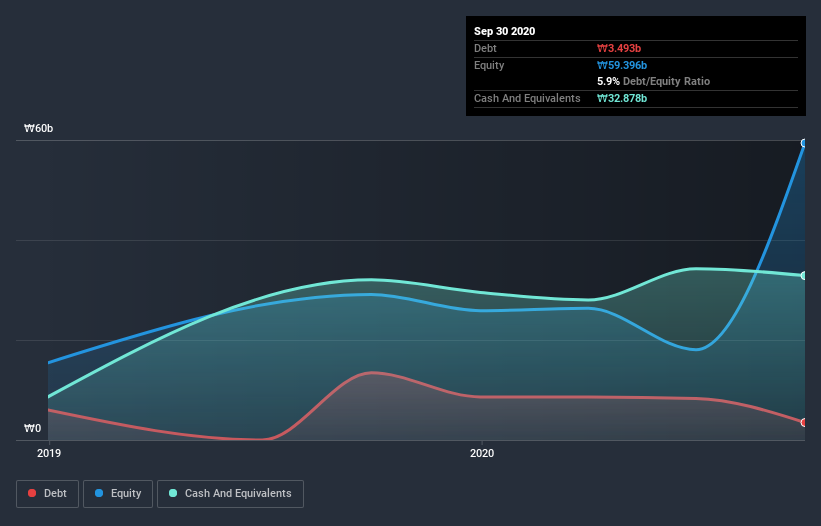- South Korea
- /
- Medical Equipment
- /
- KOSDAQ:A253840
Sugentech (KOSDAQ:253840) Seems To Use Debt Quite Sensibly
The external fund manager backed by Berkshire Hathaway's Charlie Munger, Li Lu, makes no bones about it when he says 'The biggest investment risk is not the volatility of prices, but whether you will suffer a permanent loss of capital.' So it seems the smart money knows that debt - which is usually involved in bankruptcies - is a very important factor, when you assess how risky a company is. Importantly, Sugentech Inc. (KOSDAQ:253840) does carry debt. But the more important question is: how much risk is that debt creating?
Why Does Debt Bring Risk?
Debt and other liabilities become risky for a business when it cannot easily fulfill those obligations, either with free cash flow or by raising capital at an attractive price. Part and parcel of capitalism is the process of 'creative destruction' where failed businesses are mercilessly liquidated by their bankers. However, a more frequent (but still costly) occurrence is where a company must issue shares at bargain-basement prices, permanently diluting shareholders, just to shore up its balance sheet. Of course, the upside of debt is that it often represents cheap capital, especially when it replaces dilution in a company with the ability to reinvest at high rates of return. The first thing to do when considering how much debt a business uses is to look at its cash and debt together.
See our latest analysis for Sugentech
What Is Sugentech's Net Debt?
The image below, which you can click on for greater detail, shows that Sugentech had debt of ₩3.49b at the end of September 2020, a reduction from ₩13.4b over a year. However, it does have ₩32.9b in cash offsetting this, leading to net cash of ₩29.4b.

A Look At Sugentech's Liabilities
We can see from the most recent balance sheet that Sugentech had liabilities of ₩5.30b falling due within a year, and liabilities of ₩2.43b due beyond that. On the other hand, it had cash of ₩32.9b and ₩601.3m worth of receivables due within a year. So it actually has ₩25.7b more liquid assets than total liabilities.
This surplus suggests that Sugentech has a conservative balance sheet, and could probably eliminate its debt without much difficulty. Succinctly put, Sugentech boasts net cash, so it's fair to say it does not have a heavy debt load!
Although Sugentech made a loss at the EBIT level, last year, it was also good to see that it generated ₩17b in EBIT over the last twelve months. There's no doubt that we learn most about debt from the balance sheet. But you can't view debt in total isolation; since Sugentech will need earnings to service that debt. So when considering debt, it's definitely worth looking at the earnings trend. Click here for an interactive snapshot.
But our final consideration is also important, because a company cannot pay debt with paper profits; it needs cold hard cash. While Sugentech has net cash on its balance sheet, it's still worth taking a look at its ability to convert earnings before interest and tax (EBIT) to free cash flow, to help us understand how quickly it is building (or eroding) that cash balance. In the last year, Sugentech's free cash flow amounted to 34% of its EBIT, less than we'd expect. That weak cash conversion makes it more difficult to handle indebtedness.
Summing up
While it is always sensible to investigate a company's debt, in this case Sugentech has ₩29.4b in net cash and a decent-looking balance sheet. So is Sugentech's debt a risk? It doesn't seem so to us. When analysing debt levels, the balance sheet is the obvious place to start. But ultimately, every company can contain risks that exist outside of the balance sheet. Case in point: We've spotted 2 warning signs for Sugentech you should be aware of.
At the end of the day, it's often better to focus on companies that are free from net debt. You can access our special list of such companies (all with a track record of profit growth). It's free.
If you decide to trade Sugentech, use the lowest-cost* platform that is rated #1 Overall by Barron’s, Interactive Brokers. Trade stocks, options, futures, forex, bonds and funds on 135 markets, all from a single integrated account. Promoted
New: Manage All Your Stock Portfolios in One Place
We've created the ultimate portfolio companion for stock investors, and it's free.
• Connect an unlimited number of Portfolios and see your total in one currency
• Be alerted to new Warning Signs or Risks via email or mobile
• Track the Fair Value of your stocks
This article by Simply Wall St is general in nature. It does not constitute a recommendation to buy or sell any stock, and does not take account of your objectives, or your financial situation. We aim to bring you long-term focused analysis driven by fundamental data. Note that our analysis may not factor in the latest price-sensitive company announcements or qualitative material. Simply Wall St has no position in any stocks mentioned.
*Interactive Brokers Rated Lowest Cost Broker by StockBrokers.com Annual Online Review 2020
Have feedback on this article? Concerned about the content? Get in touch with us directly. Alternatively, email editorial-team (at) simplywallst.com.
About KOSDAQ:A253840
Sugentech
Develops and sells in-vitro diagnostic systems and products based on biotechnology, information technology, and nanotechnology in South Korea and internationally.
Flawless balance sheet with very low risk.
Market Insights
Community Narratives




